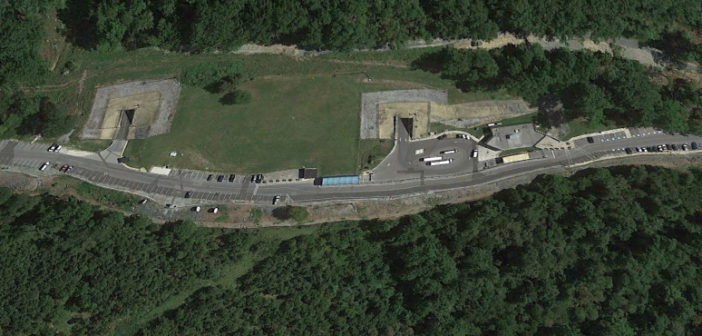What was once an underground nuclear bunker, today remains a mystery
By James Rada Jr.
Three hours after terrorists crashed a passenger plane into the Pentagon on Sept. 11, 2001, five helicopters landed on Raven Rock Mountain just north of the Pennsylvania state line in Adams County. SUVs quickly carried the passengers from the helipad, down a mountain road, and through a large portal that led underneath the mountain.
The passengers were not seen, but it is believed that Vice President Dick Cheney directed his office from that location for the next few days.
The incident brought Site R back into the spotlight. The Underground Pentagon or Harry’s Hole, as it was called during its construction, had nearly fallen into disuse—or so most people believed. It turns out that the Alternate Joint Communications Center (yet another name for Site R) still had a purpose in keeping the country running in case of an attack.
Beginnings
President Harry S. Truman ordered the construction of the underground complex after the Soviets exploded their first nuclear bomb, according to a Scripps Howard News Service article in 1991. However, other reports state that planning for the facility began in 1948, a year before the Soviets detonated their first atomic bomb.
Either one or neither could be true. That’s the catch with Site R. Not a lot of facts are known, but there is plenty of speculation. Some of it is generated on purpose, such as the parody website whitehouse.gov1.info that offers tours and souvenirs from Site R.
The federal government took more than 280 acres on Raven Rock Mountain in January, and construction began the next month. It was supposed to be a secret project, but it is hard to keep something that big under wraps. A 1975 article that ran in newspapers nationwide noted, “Workers weren’t screened so word got out. During construction, salesmen and equipment servicemen were allowed into the huge cavern without any security checks.”
Even without the screenings, locals soon knew what was happening because of the traffic and construction noise. “It knocked you right out of bed,” nearby resident Earl Harbaugh said in a 1997 Associated Press article.
One man decided to investigate the site on his own. He got as far as the tunnels before site security caught him. “They threatened him with all kinds of things,” local resident John Keller told the Associated Press.
By 1953, the tunnels under the mountain and a three-story building had been completed. In 1955, the federal government conducted a test evacuation of 1,500 government employees who ran the government from beneath the mountain for days.
But, why Raven Rock? Why was that particular site chosen? It is an isolated location, but it is close enough
to Washington, D.C., to be a short helicopter flight, but far enough away to be outside of the danger zone if there were ever a disaster.
Military support, at the time, was only five miles away at Fort Ritchie. Most importantly, the mountain was made of very hard greenstone granite.
Out of Sight
Gene Bowman, who lived next to the site, had been one of the project laborers. He told the New York Times Magazine, “They just said they were building a tunnel. Wasn’t nobody interested in what they were doing.” He described the tunnels as a town: “Streets and everything. And they have to pump the air in.”
Two more buildings were constructed beneath Raven Rock in 1963. “It was built to serve as an alternate Pentagon, but it also served as a secret communications center that would be activated in case of an attack on the U.S. in the 1950s. During this time, a War Room Annex was established and headquarters for the United States Air Force advanced,” Scripps Howard News Service reported.
During its peak usage, the underground complex now has five buildings, and within each building are office spaces, dining facilities, a hospital, dental clinic, and chapel, according to Scripps Howard.
In 1989, a new cooling tower and reservoir were built. The site is built above the reservoir and the cool air in the reservoir chamber is circulated throughout the 265,000-square-foot complex to help keep it cool. Although the chamber is naturally cool, the computers and lights create heat that is trapped within the mountain so additional air conditioning is needed.
Different newspaper articles had pointed out that the complex contains a fitness center, barbershop, medical and legal services, chapel, smoking area, convenience store, six 1,000 kilowatt generators, and 35 miles of cable on 180 telephone poles. Cars can also travel on streets through the tunnels. One rumor said there was even a Starbucks beneath the mountain.
The idea initially was to give the site some familiar comforts in case the doors needed to be closed and the staff sealed inside. The most commonly cited capacity number for Site R was that it could house 3,000 people.
There are also stockpiles of military MREs and chemical suits in case of an attack. So, while the staff might have been able to workout or get a haircut during a nuclear disaster, they wouldn’t have been eating gourmet meals or even fast food.
For a secret site, Site R is easily visible. The barbed wire fencing can be seen while driving along some of the surrounding roads, although to the naked eye it surrounds a mountain with a few towers at the top of it. If you were to try and get past that fencing, though, you would quickly be met by security. The only sign of the underground complex is the four entrance tunnels, which aren’t readily visible.
“There are four entrances, but I’ve only ever been able to find three of them,” resident Hal Neill told the Pittsburgh Post-Gazette in 2001.
You can see the main entrance on Harbaugh Valley Road. It is a gated entrance with a large sign that reads: “Raven Rock Mountain Complex. Site R. Secured by the Raven Rock Military Police Company.”
“There was no cellphone service. In fact, a phone seemed to turn itself off,” Knight Ridder News Service reported.
Changing Mission
As weapons became more effective over the years, it is believed that sometime in the 1970s the destructive power of modern weapons became enough to destroy Site R in a wartime situation. According to the New York Times Magazine, the site became more of a “garage, used in part to house the
mobile communications units (trucks) that are supposed to fan out to
remote areas in case of war or other disaster to ensure the continuity of government operations.”
In 1992, Raven Rock went off 24-hour alert. When Fort Ritchie closed in 1998, command of the site was transferred to Fort Detrick in Frederick, Md.
Although the site is no longer in a state of 24/7 readiness, what actually goes on inside the mountain is not publicly known. A few tidbits get out now and then, but the public is still not allowed access into the site, which still operates as one of the pieces of hidden history in Adams County.




